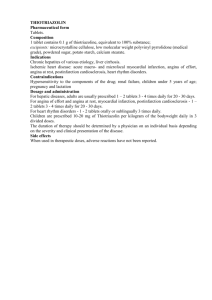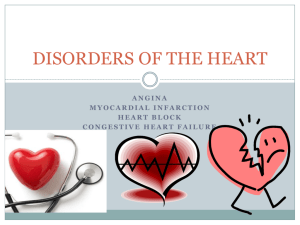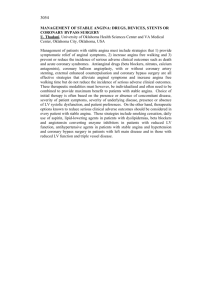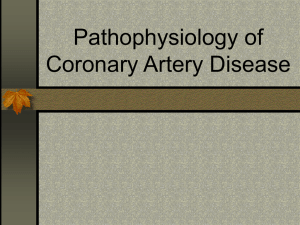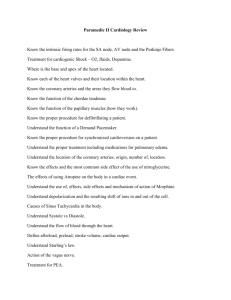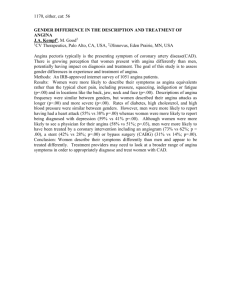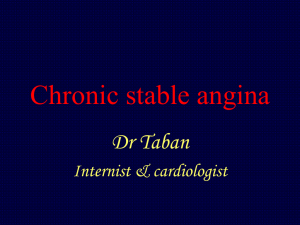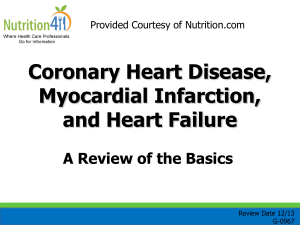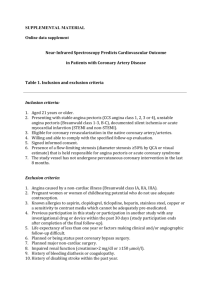ไม่มีชื่อเรื่องภาพนิ่ง
advertisement
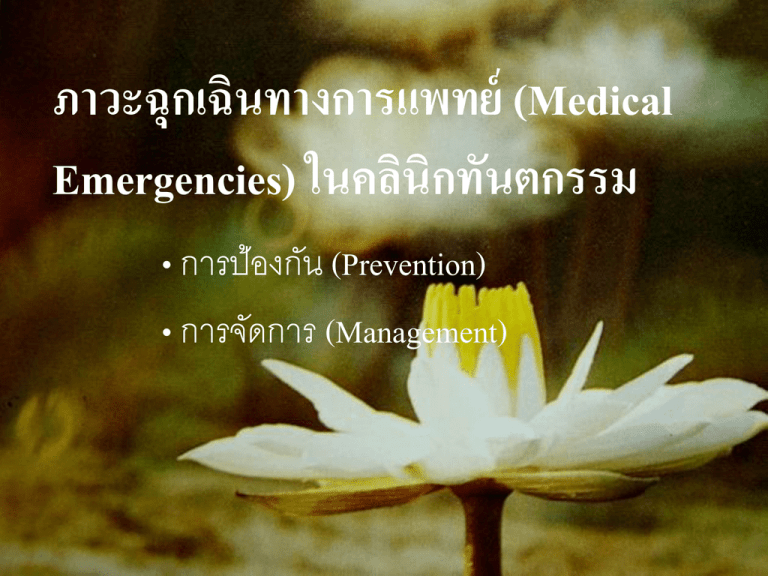
ภาวะฉุกเฉินทางการแพทย์ (Medical Emergencies) ในคลินิกทันตกรรม • การป้องกัน (Prevention) • การจัดการ (Management) • Emergencies in dental practice can occur to any person, any time. • How to manage, it is the most difficult thing at time occurred. • The majority emergency is syncope. Others – – – – – – – allergic reaction angina pectoris postural hypotension seizures asthmatic attack hyperventilation hypoglycemia • • • • • anaphylactic reaction cerebrovascular accident adrenal insufficiency thyroid storm etc Composition of consciousness – – – – Brain O2 Glucose Effective hemodynamic Fact … of human brain • Uses O2 approx. 20% of total O2 • Uses glucose approx. 65% of total glucose • Uses approx. 20% of total circulation/min (750 ml.min.) Balance mechanism of : • Hemodynamic • Respiration • Metabolism • Neurologic Caused from impair …….. – Hemodynamic – Respiration – Metabolism – Neurologic How to avoid these complications? • • • • Prevention is the best Good history taking Good preoperative preparation Good operative controls Possible causes of unconsciousness in the dental office • Vasodepressor syncope • Drug administration /ingestion • Orthostatic hypotension • Epilepsy • Hypoglycemic reaction • Acute adrenal insufficiency • Acute allergic reaction • Acute myocardial infarction • Cerebrovascular accident • Hyperglycemic reaction • Hyperventilation syndrome Alteration of consciousness • • • • • • • Cerebrovascular accident (CVA) Seizures Hypoglycemia / Hyperglycemia Adrenal insufficiency Thyroid storm Hyperventilation Drug overdose Syncope is the most common occurred. Factors influence • Stress and anxiety • Health status • Drugs How syncope occur? In normal : circulation compensation mechanism play role in correction of deficiency O2 supply to the brain. How syncope occur? In syncope : circulation compensation mechanism fail to increase O2 need from the brain Signs for syncope Early : Feeling of warmth Loss of color : pale or ashen=gray skin tone Heavy perspiration Complaints of feeling “bad” of “faint” Nausea Blood pressure approximately baseline Rapid heart rate Signs for syncope Late : – – – – – – – – Pupillary dilation Yawning Hyperpnea Cold hands and feet Hypotension Bradycardia Dizziness Loss of consciousness Critical consideration • Timing of detection and correction • Maintain O2 level to the brain : Airway, Breathing, Circulation (ABC - Basic life support) Orthostatic hypotension • • • • Failure of the baroreceptor reflex Loss of compensate mechanism Reflex bradycardia Loss of consciousness Drugs producing orthostatic hypotension Category Generic name Proprietary name Antihypertensives Guanethidine Ismelin Phenothiazines Chlorpromazine Thioridazine Doxepin Amitriptyline Imipramine Thorazine Mellaril Sinequan Elavil Tofranil Presamine Demerol Morphine Dopar Larodopa Tricyclic antidepressants Narcotics Meperidine Morphine Antiparkinson drugs Levodopa (L-dopa) Unconsciousness Assessment : Check for Breathing – Look the chest to rise and fall – Listen for air escaping during exhalation – Feel for the flow of air Unconsciousness : no response to stimuli P - position : SUPINE Call for help : EMS activation A, B = Airway (head tilt - chin lift) Artificial Assisted Breathing (if no self respiration) C = check circulation Carotid pulse absent Carotid pulse present Check medical history Vital signs Recovery Vasodepressor syncope Activate EMS unrecovery Orthostatic hypotension Initiate CPR Immediate transportation Sequence of BCLS • Assessment • EMS Activation • ABCs of CPR • D of Defibrillation ABCs of CPR • Airway • Breathing • Circulation Airway • Position the victim • Rescuer position • Open the Airway – Head Tilt - Chin Lift Maneuver – Jaw Thrust Maneuver – Recommendations for Opening the Airway Classification of causes of unconsciousness by mechanism Mechanism Inadequate delivery of blood or oxygen to the brain Clinical example Acute adrenal insufficiency Orthostatic hypotension Vasodepressor syncope Classification of causes of unconsciousness by mechanism Mechanism Systemic or local metabolic deficiencies Clinical example Acute allergic reaction Drug ingestion and adminstration Nitrites and nitrates Diuretics Sedatives-narcotics Local anesthetics Hyperglycemia Hyperventilation Hypoglycemia Classification of causes of unconsciousness by mechanism Mechanism Direct or reflex effects on nervous system Clinical example Cerebrovascular accident Convulsive episodes Psychic mechanisms Emotional disturbances Hyperventilation Vasodepressor syncope Causes of chest pain Cardiac related • Angina pectoris • Myocardial infarction Non-cardiac related • • • • • • • • Muscle strain Pericarditis Esophagitis Hiatal hernia Pulmonary embolism Dissecting aortic aneurysm Acute indigestion Intestinal “gas” Chest pain is one of the major clinical clues to the presence of significant heart disease. Definition of Terms “Atherosclerosis” is a special type of thickening and hardening of medium - sized and large arteries because of deposits of a fatty substance. • is an ongoing process • is a reactive biologic response of arteries to the forces being generated by the flow of blood. Atherosclerosis is the major factor underlying all forms cardiovascular disease. Normal structure Development of atherosclerosis Proliferative change Development of atherosclerosis Lipid deposition The development of ACS Early plaque formation Significant plaque formation Plaque rupture Thrombus Coronary artery disease is the presence of atherosclerosis in the coronary arteries. • Angina pectoris • Myocardial infarction Angina is a transient discomfort (usually less than 15 minutes) due to a temporary lack of adequate blood supply to the heart muscle. Myocardial infarction is defined as death of heart muscle (myocardium) as the result of prolonged inadequate blood flow and oxygen delivery. Acute coronary syndromes encompasses symptomatic condition resulting in an inadequate blood supply to the heart; including unstable angina and AMI. AMI (heart attack) is defined as death of heart tissue due to blockage of a coronary artery caused by atherosclerosis and thrombus formation. Unstable angina • Angina that is continuing, prolonged or occurring at rest. • Represents a syndrome that lies between angina pectoris and AMI. Unstable Angina pectoris --------------> AMI Angina Risk factors : Heart attack • Risk factors that cannot be changed Age Heredity Gender Race • Risk factors that can be changed Cigarette smoking High blood pressure High blood cholesterol level Physical inactivity Diabetes Obesity Excessive stress Diagnosis Electrocardiogram (EKG) Exercise stress test Echocardiogram Coronary angiography Treatment 1. Coronary artery bypass graft surgery (CABGS) 2. Medical therapy 3. Percutaneous Transluminal Coronary Angioplasty (PTCA) หรื อ Percutaneous Coronary Intervention (PCI) Drugs and bleeding in patient with CAD • • • • Aspirin Plavix Ticlid Coumadin Angina pectoris • Potential problem related to dental care 1. Stress and anxiety related to dental visit may precipitate angina attack 2. Myocardial infarction 3. Sudden death Angina pectoris • Prevention of complication 1. Detection of patient 2. Referral of patient for medical evaluation and treatment • Prevention of complication 3. Known case with medical treatment for angina – Stress reduction protocol • Premedication • Open and honest communication • Morning appointments • Short appointments • Nitrous oxide - oxygen – Avoid excessive amounts of epinephrine Emergency action plan for a person with signals of heart attack Unknown case of CAD Known case of CAD Recognize the signals of a heart attack Recognize the signals of heart attack Stop activity and sit or lie down Wait about 5 minutes to see if the symptom go away. If the pain persists : Stop activity and sit or lie down Take 1 nitroglycerin tablet at a time at 3 - to 5 minutes intervals to maximum total dose of 3 tablets. If pain persists. Transport patient to hospital • Potential problem related to dental care 1. Cardiac arrest 2. Myocardial infarction 3. Angina pectoris 4. Congestive heart failure 5. Bleeding tendency secondary to anticoagulant • Prevention of complication 1. No routine dental care until at least 6 months after infarction 2. Medical consultation – Current status – Medication used 3. Stress reduction protocol – Premedication – Open and honest communication – Morning appointment – Short appointment – Nitrous oxide - oxygen 4. Avoid excessive amounts of epinephrine 5. Check PT (Anticoagulant medication) Management of Acute Myocardial Infarction Step 1. Diagnosis Administer nitroglycerin 2. Initiate BLS 3. Summon medical assistance 4. Administer oxygen and monitor vital signs 5. Relive pain Morphine Nitrous oxide - oxygen 6. Transport patient to hospital ผูป้ ่ วยชายอายุ 68 ปี มาด้วยมีส่วนแหลมคมของฟัน กรามบนซ้าย เป็ นฟันที่รับการรักษาคลองรากฟั นและ มีตวั ฟันแตกออก วางแผนการรักษาโดยการถอนฟัน จากการซักประวัติ ผูป้ ่ วยเป็ นโรคหลอดเลือดหั วใจ ได้รับการรักษาโดยการทาบอลลูน และรับประทานยา อยูเ่ ป็ นประจา Medical Problem List 1. Coronary artery disease : double - vessel Status : post PCI พ.ค. + มี.ค. 46 at present : asymptomatic 2. DM : controlled 3. HT : controlled 4. Old CVA : Left hemiparesis 5 yrs ago at present : complete recovery 5. Mild renal insufficiency 6. Mild late onset asthma Current medication 1. Aspent gr. V 2. Plavix 3. Plendil 4. Minidiab 5. Bestatin 6. Singvalac 1 x 1 orally pc. 1 x 1 orally pc. 1 x 2 orally pc. 1 x 1 orally pc. 1 x 1 orally pc. 1 x 1 hs.
